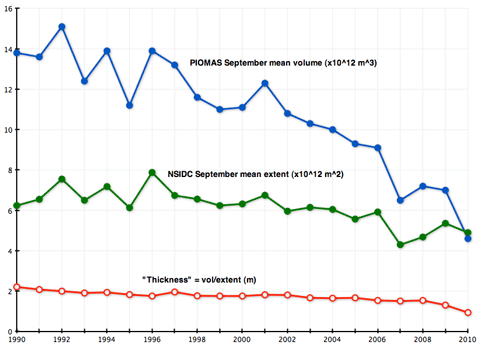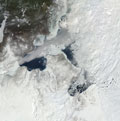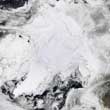 A few days ago I used a combination of Arctic sea ice volume data from the University of Washington’s PIOMAS model and NSIDC sea ice extent numbers to project that the Arctic Ocean would be effectively ice-free in late summer within ten years. The key to that exercise was the rate at which the volume of sea ice has been declining — 350 km3 per year over the last 30 years for the full dataset, 410 km3 per year over the last 20, and 740 km3 over the last decade at summer minimum. The rate of volume decline has obviously been increasing. Using those numbers to project ice extent in the future is one thing, but they also tell us something interesting about the overall Arctic heat budget — and we can use that to make a rough guess about when the Arctic will become ice-free year round. The answer is surprising…
A few days ago I used a combination of Arctic sea ice volume data from the University of Washington’s PIOMAS model and NSIDC sea ice extent numbers to project that the Arctic Ocean would be effectively ice-free in late summer within ten years. The key to that exercise was the rate at which the volume of sea ice has been declining — 350 km3 per year over the last 30 years for the full dataset, 410 km3 per year over the last 20, and 740 km3 over the last decade at summer minimum. The rate of volume decline has obviously been increasing. Using those numbers to project ice extent in the future is one thing, but they also tell us something interesting about the overall Arctic heat budget — and we can use that to make a rough guess about when the Arctic will become ice-free year round. The answer is surprising…
Continue reading “Gone for good: Arctic Ocean ice free all year by the 2040s?”




